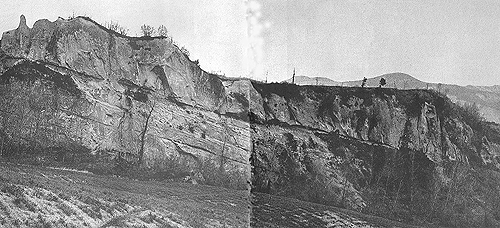
Surface of synchronous erosion
Plate 71

Surface of synchronous erosion
Plate 71
A set of sandstone beds is sharply cut by a low-angle discordant surface showing terraced scours in the central part of the picture. A huge sandstone bed overlies the discontinuity: it is not composite, i.e., the product of amalgamation of several beds, but an individual depositional event. A turbidity current of high volume accumulated it. As the volume (or the thickness) of a gravity-driven, density current is one of the factors controlling its energy and velocity, we can assume that this high-volume flow had an erosional capacity.
Having thus recognized an erosional surface that truncates various beds but is mantled only by one, and one deposited by a flow of high energy, we can infer that the same event was responsible for both erosion and deposition, and that the time gap between them was minimum and geologically insignificant. Actually, most surfaces of instantaneous erosion can be accounted for by catastrophic events, both in turbiditic and other systems.
Upper part of Marnoso-arenacea Formation, Santerno valley, northern Apennines.
One further remark about dating rocks and sediments: every method invented by stratigraphers and geochronologists to this purpose has its own limits of precision, or temporal resolution . Let us assume that this limit is 10,000 years. If a sequence of beds has employed 3,000 years to accumulate, the depositional and erosional events we recognize in it cannot be dated and are apparently synchronous. They can only be placed in their relative order of succession. This makes the difference between a cardinal (truly quantitative) concept, or measurement, and an ordinal one (order or sequence of things): a difference that must be clear to geologists and non geologists as well.
An actualistic approach (monitoring erosive processes in the modern world, recording their rates and tempos, and extrapolating data back in time to interpret erosional surfaces) has a limited usefulness in this respect for two main reasons: 1) the Recent record is too limited in time, and exceptional events have a return time that exceeds it; 2) this period is rather exceptional with respect to the geological past (the climate is colder and more continental than usual, many young mountain chains dominate the landscape, etc.). It cannot be regarded as representative of most geological history.
| Photo: R. Biscaretti 1970. |